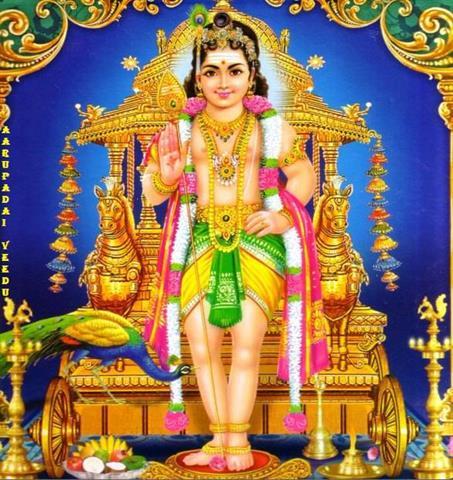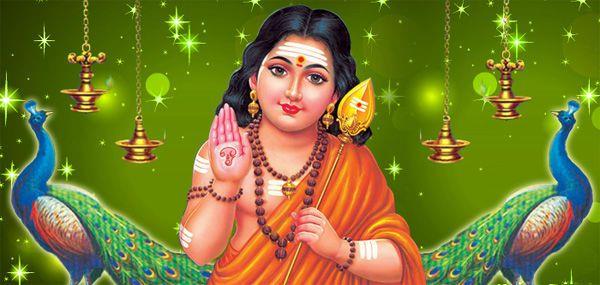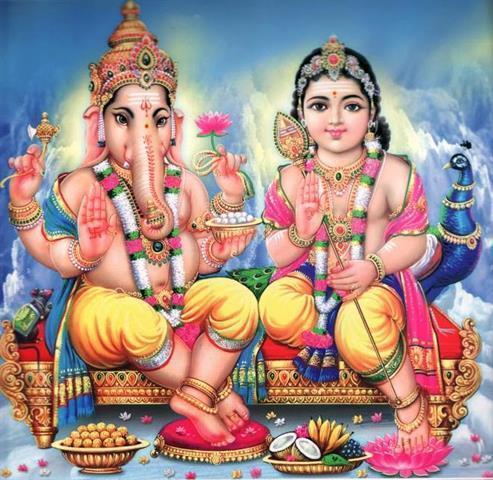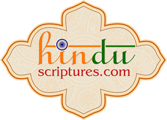KARTIKEYA- THE DEVA SENAPATHI
Contents
- Introduction
- Names
- Historical Perspective
- Vehicle of Kartikeya
- Legends around Kartikeya’s weddings
- Symbolism of Kartikeya
- Kartikeya in sangam literature
- Worship of Kartikeya
- Worship abroad
- References
Introduction
 There are different stories about the origin of Kartikeya. The most popular story is “Tarakasur vadh”. According to legends Siva and Paravati gave birth to Kartikeya to destroy the demon Tarakasur. Before he was born, Paravati performed severe austerities so that he would have extraordinary skills and strength. He was born in a forest of (grass that grew like) arrows (Sara vana) there by earning the epithet of Saravanabhava. He was reared by six divine mothers from the constellation of Krittika. When he grew up, he became the commander-in-chief of the divine army which earned him the name of Deva Senapathi. He was summoned by Lord Siva to undertake an expedition against the demon Tarakasura. All the gods and goddesses equipped him with various weapons and gifts and also accompanied him to the battle field where he slew the demon and saved the worlds from anarchy. His chief exploits include slaying of Tarakasur, Banasur and Pralambasur, protecting the yagna of Narada, tunneling through the mountain Krauncha, and a debate with Brahma in which he showed his true wisdom. He is considered to be eternal. Hence, the name Kumara.
There are different stories about the origin of Kartikeya. The most popular story is “Tarakasur vadh”. According to legends Siva and Paravati gave birth to Kartikeya to destroy the demon Tarakasur. Before he was born, Paravati performed severe austerities so that he would have extraordinary skills and strength. He was born in a forest of (grass that grew like) arrows (Sara vana) there by earning the epithet of Saravanabhava. He was reared by six divine mothers from the constellation of Krittika. When he grew up, he became the commander-in-chief of the divine army which earned him the name of Deva Senapathi. He was summoned by Lord Siva to undertake an expedition against the demon Tarakasura. All the gods and goddesses equipped him with various weapons and gifts and also accompanied him to the battle field where he slew the demon and saved the worlds from anarchy. His chief exploits include slaying of Tarakasur, Banasur and Pralambasur, protecting the yagna of Narada, tunneling through the mountain Krauncha, and a debate with Brahma in which he showed his true wisdom. He is considered to be eternal. Hence, the name Kumara.
Another legend describes him as the son of Lord Agni. The Puranas narrate that Kartikeya was born under strange circumstances. Agni swallowed the energy of Siva as per the wishes of gods, but much to the annoyance of Paravati. Unable to bear the intensity of the energy Agni secretly impregnated the six wives of Rishis with it through the pores in their skin. After bearing the energy of Siva they were unable to carry it further. So they dropped it on the Himalayas. Himavant the mountain god was also unable to bear the energy. So he dropped it in the river Ganges. The goddess Ganges also could not bear the intensity of the energy. She managed to carry it for some distance and then left it in the middle of reeds where it eventually materialized into a beautiful baby named Kumara. Thus we have different stories about the origin of Kartikeya revealing that he was born for some major purpose. He was born for battles, to destroy all demons.
Names
Kartikeya is variously known as
Skanda, Murugan and Subramaniyan, as the Hindu god of war. Senthil, Vēlaṇ, Kumāran (meaning 'prince or child or young one'),
Swaminatha (meaning 'smart' or 'clever'),
Saravaṇa, Arumugam or Shanmuga (meaning 'one with six faces'),
Dhandapani (meaning God with a club),
Guhan or Guruguha (meaning 'cave-dweller'),
Subrahmanya, Kartikeya and Skanda (meaning 'that which is spilled or oozed) He was also known as Mahasena and the Kadamba dynasty kings worshiped him by this name. The Atharva Veda describes Kumaran as 'Agnibhuh' or son of Agni. The Chandogya Upanishad refers to Skanda as the "way that leads to wisdom". He was reared by six divine mothers from the constellation of Krittika, which earned him the name of Kartikeya. With six faces he suckled the milk of his six foster mothers and thereby earned the name Shanmukha. Kartikeya’s other name, Shadanana, which means ‘one with six heads’ corresponds to the five senses and the mind. The six heads also stand for his virtues which enable him to see in all the directions - an important attribute that ensures that he counters all kinds of blows that can hit him.
The war imagery and the six heads of Kartikeya indicate that if humans wish to lead themselves efficiently through the battle of life, they must always be alert lest they are shown the wrong path by crafty people with the six demonic vices: Kama (sex), krodha (anger), lobha (greed), moha (passion), mada (ego) and matsarya (jealousy).

Historical Perspective
Historically he is a god of great antiquity. Some of the coins of Kushanas bear the name and image of Skanda-Kumaro-Bizogo (Skanda Kumara Vishakha) and Shiva. They also bear the title of Devaputra, probably as a divine origin of the king and his identification with Skanda. The Yaudheyaas who played an important role in the decline of Kushanas worshipped Skanda and issued coins bearing images of Skanda and Mayura. The Guptas were also worshippers of Skanda and Shiva as evidenced from the fact that one of the Gupta rulers was named Skanda Gupta (455 - 467 AD) and another Kumara Gupta (414 - 455 AD). The Kushanas, who governed from what is today Peshwar, and the Yaudheyas, a Jat republican clan in the Punjab, stuck coins bearing the image of Skanda. The deity was venerated also by the Ikshwakus, and the Guptas. We find references about him in the Vedas, the Upanishads, the Puranas, the Mahabharata and Ramayana, Patanjali's Yogasutras and even some early Buddhist texts. He is believed to be of the nature of fire god Agni. It is interesting to note that with the spread of Brahmanism and later Saivism, Skanda Kumara became very popular in southern India, where several local deities and nature spirits, mostly worshipped by the local tribes and rural people were gradually identified with him and integrated into Saivism under the generic name Kumara or Kartikeya. One of the major Puranas, the Skanda Purana is dedicated to him. In the Bhagavad-Gita (Ch.10, Verse 24), Krishna, while explaining his omnipresence, names the most perfect being, mortal or divine, in each of several categories. While doing so, he says: "Among generals, I am Skanda, the lord of war." Two of the Gupta kings, Kumaragupta and Skandagupta, were named after him. His youth, beauty and bravery were much celebrated in Sanskrit works like the Kathasaritsagara. Kalidasa made the birth of Kumara the subject of a lyrical epic, the Kumaarasambhavam. In ancient India, Kartikeya was also regarded as the patron deity of thieves, as may be inferred from the Mrichchakatikam, a Sanskrit play by Shudraka, and in the Vetala-panchvimshati, a medieval collection of tales. This association is linked to the fact that Kartikeya had dug through the Krauncha mountain to kill the demon Taraka and his brothers (in the Mrichchakatikam, Sarivilaka prays to him before tunnelling into the hero's house).
However, Kartikeya's popularity in north India receded from the Middle Ages, and his worship is today virtually unknown there. Reminders of former devotion to him include a temple at Achaleshwar, near Batala in Punjab, and another temple of Skanda on the top of the Parvati hill in Pune, Maharashtra. Another vestige of his former popularity can be seen in Bengal, where he is worshipped during the Durga Pooja festivities alongside Durga.
Vehicle of Kartikeya
His vehicle is a peacock, a colourful bird that grips with its feet a serpent, which symbolizes ego and the desires of people. The peacock symbolizes the destruction of harmful habits and victory over sensual desires.
Legends around Kartikeya’s weddings
In South India he is known as lord Murugan or lord Subramanya where he is worshipped as the God of marriage, love. But it is entirely opposite in North India. In north he is known as Kumara. Women are not allowed to worship Kartikeya and they are not allowed to enter the temple of Kartikeya.
 The consorts of Lord Shanmukha are Valli and Deivayanai. Valli stands for Iccha Shakti—the Power of Will. And Deivayanai, stands for Kriya Shakti—the Power of Action. Thus should a Jiva aspiring to Godliness, having brought the will-power under control, strive ceaselessly till it reaches the goal. Hence the three Shaktis, in the form of Vel—Jnana Shakti (knowledge), Valli—Iccha Shakti, and Deivayanai—Kriya Shakti, form part of Lord Shanmukha, who is also named as Saktidhara. Glory to the Lord of the Shaktis! Glory to the Lord who dispels ignorance amongst the devotees through His Velayudha. (the spear).
The consorts of Lord Shanmukha are Valli and Deivayanai. Valli stands for Iccha Shakti—the Power of Will. And Deivayanai, stands for Kriya Shakti—the Power of Action. Thus should a Jiva aspiring to Godliness, having brought the will-power under control, strive ceaselessly till it reaches the goal. Hence the three Shaktis, in the form of Vel—Jnana Shakti (knowledge), Valli—Iccha Shakti, and Deivayanai—Kriya Shakti, form part of Lord Shanmukha, who is also named as Saktidhara. Glory to the Lord of the Shaktis! Glory to the Lord who dispels ignorance amongst the devotees through His Velayudha. (the spear).
The two wives, Deivayanai and Valli, also symbolise the two types of devotees who strive for Moksha or Liberation through union or oneness with the Supreme. One type consists of those who rigidly and sincerely observe the injunctions and follow the teachings of the Vedic scriptures and are thus the followers of Vaidika Karmas. That type is represented by Deivayanai, whom Subramanian married in the regular orthodox way. The other type consists of the ardent Bhaktas who attach more importance to right mental feeling and emotion than to rules and regulations. This type is symbolised by Valli, who grows as the foster-daughter of the hunter king, Nambi. Subramanian marries her in the combined Gandharva and Paisacha modes of marriage. He manifests love in wooing her and uses Force In Fighting Against Her Relations Who Try To Obstruct Him.
Symbolism of Kartikeya
 Kartikeya symbols are based on the weapons – Vel, the Divine Spear or Lance that he carries and his mount the Peacock. He is sometimes depicted with many weapons including: a sword, a javelin, a mace, a discus and a bow although more usually he is depicted wielding a shakti or spear. This symbolizes his method of purification of human ills. His javelin is used to symbolize his far reaching protection, his discus symbolizes his knowledge of the truth, his mace represents his strength and his bow shows his ability to defeat all ills. His peacock mount symbolizes the destruction of the ego. His six heads represent the six Siddhis bestowed upon Yogis over the course of their spiritual development. This corresponds to his role as the bestower of siddhis.
Kartikeya symbols are based on the weapons – Vel, the Divine Spear or Lance that he carries and his mount the Peacock. He is sometimes depicted with many weapons including: a sword, a javelin, a mace, a discus and a bow although more usually he is depicted wielding a shakti or spear. This symbolizes his method of purification of human ills. His javelin is used to symbolize his far reaching protection, his discus symbolizes his knowledge of the truth, his mace represents his strength and his bow shows his ability to defeat all ills. His peacock mount symbolizes the destruction of the ego. His six heads represent the six Siddhis bestowed upon Yogis over the course of their spiritual development. This corresponds to his role as the bestower of siddhis.
Kartikeya In Sangam Literature
Sangam period is the period in the history of ancient southern India (known as the Tamilakam) spanning from 300 BCE and 300 CE. Poetic collection of this period contains 2381 poems composed by 473 poets, some 102 of whom remain anonymous. The poems belonging to the Sangam literature were composed by Tamil poets, both men and women, from various professions and classes of society. These poems were later collected into various anthologies, edited, and with colophons added by anthologists and annotators around 1000 AD. Sangam literature fell out of popular memory soon thereafter, until they were rediscovered in the 19th century by scholars such as Arumuganavalar,C.W. Thamotharampillai and U. V. Swaminatha Iyer.
Sangam Poems falls into two categories: the 'inner field' (Agam), and the 'outer field'(Puram) as described even in the first available Tamil grammar, the Tolkappiyam. Tolkappiyam, possibly the most ancient of the extant Sangam work, glorifies Murugan, "the red god seated on the blue peacock, who is ever young and resplendent," as "the favoured god of the Tamils." The Sangam poetry divided space and Tamil land into five allegorical areas (tinai) and according to the Tirumurugatruppadai (c. 400–450 AD) attributed to the great Sangam poet Nakkiirar, Murugan was the presiding deity the Kurinci region (hilly area). (Tirumurugatruppadai is a deeply devotional poem included in the ten idylls (Pattupattu) of the age of the third Sangam). The other Sangam era works in Tamil that refer to Murugan in detail include the Paripaatal, the Akananuru and the Purananuru. One poem in the Paripaatal describes the veneration of Murugan thus:
"We implore thee not for boons of enjoyment or wealth,
But for thy grace beatific, love and virtuous deeds."
According to the Tamil devotional work Thiruppugazh, "Murugan never hesitates to come to the aid of a devotee when called upon in piety or distress". In another work, Thirumurukkatrupadai, he is described as a god of eternal youth;
His face shines a myriad rays light and removes the darkness from this world.
Old Sangam literature describes Kartikeya in these ways. Hence we can say that the influence of Kartikeya was more in South India than in the north.

Worship Of Kartikeya
The worship of Lord Shanmukha is very common in South India. Almost every town in the South has its temple dedicated to Lord Shanmukha. The Tamils have named Shanmukha as Murugan. Just as the God of Winds is Vayu, the God of Waters Varuna, the Tamil term for the Lord of Nature is Murugan. In Tamil Nadu, Murugan has continued to be popular with all classes of society right since the Sangam age. This has led to more elaborate accounts of his mythology in the Tamil language, culminating in the Tamil version of Skanda Paraná, called Kandha Purānam, written by Kacchiappa Sivachariyar (1350–1420 AD.) of Kumara Kottam in the city of Kanchipuram. (He was a scholar in Tamil literature, and a votary of the Shaiva siddhanta philosophy.) During His bachelorhood, Lord Murugan is also regarded as Kumara swami (or Bachelor God), Kumara meaning a bachelor and Swami meaning GOD.
Murugan is particularly worshipped for a six day period of fast and prayer in the Tamil month of Aippasi known as the Skanda Shasti. He is also venerated during Thai Pusam, celebrated by Tamil communities worldwide, near the full moon of the Tamil month Thai. This is symbolic of the day when Murugan was given a Vel by his mother, Parvati, in order to vanquish the asuras. Thirukarthigai or the full moon of the Tamil month of Karthigai signifies his birth. Each Tuesday of the Tamil month of Adi is also dedicated to the worship of Murugan.
Kartikeya's popularity in North India receded from the Middle Ages onwards, and except in some regions of Haryana, his name was almost totally unknown. There is a very famous Murugan temple in Pehowa town in Haryana. Women stay away from this temple, as it celebrates the Brahmachari form of Kartikeya. In Kerala, the Subramanya temple in Haripad and the Udayanapuram Subrahmanya Swami temple in Kottayam are two of the several temples dedicated to the worship of Murugan. In Tulu Nadu, there is the famed temple called Kukke Subramanya Temple, where Murugan is worshipped as the Lord of the serpents.

Worship abroad
In Sri Lanka, Murugan is venerated by both Tamil Hindus and Sinhalese Buddhists. Several temples exist throughout the island. He is a favourite deity in this part of the world and it is believed he never hesitates to come to the aid of a devotee when called upon. In the south of Sri Lanka, Kartikeya is worshipped at the temple in Kataragama (Kathirkamam), where he is hailed as Katragama Deva (Lord of Katragama) or Kathirvel. This temple is next to an old Buddhist place of worship. Local legend holds that Lord Murugan alighted in Kataragama and was smitten by Valli, one of the local aboriginal lasses. After a long courtship, they got married. The Nallur Kandaswamy temple, the Maviddapuram temple and the Sella Channithy temple near Valvettiturai are important Murugan temples in Jaffna. The Chitravelautha temple in Verukal on the Trincomalee border and the Mandur Kandaswamy temple in Batticaloa are equally famous. The late medieval-era temple of the tooth in Kandy, dedicated to the tooth relic of the Buddha, has a Kataragama deity shrine adjacent to it dedicated to the veneration of Skanda in the Sinhalese tradition.
The most famous Murugan temple in Malaysia is located at the Batu Caves, very close to Kuala Lumpur. There is a 42.7m high statue of Lord Murugan at the entrance to the Batu Caves, which is the largest Lord Murugan statue in the world. Sri Thendayuthapani Temple in Tank Road, Singapore, is yet another major Hindu temple where each year the Thai Pusam festival takes place with devotees of Lord Murugan carrying Kavadis seeking penance and blessings of the Lord.
The Highgate Hill Murugan temple in the UK is one of the oldest and most famous. In London, Sri Murugan temple in Manor Park is a well known temple. In Sydney, the Murugan temple in Parramatta (Mays Hill) is a major Hindu temple for all Australian Hindus, whereas, in the USA, The Shiva Murugan Temple in Concord, Northern California and The Murugan Temple of North America in Maryland, Washington DC region are extremely popular. In Toronto, Canada, Canada Kanthasamy Temple is known amongst many Hindus in Canada.
The Sri Sivasubramaniar Temple, located in the Sihl Valley in Adliswil, is the most famous and largest Hindu temple in Switzerland. Kartikeya is a favourite God worshipped throughout the entire world.
- Ancient India by R.C.Mujumdaar( 8th reprint 2013 and first edition was in 1952)
- Sanskruti parichay by Tilak Maharashtra Vidhyapith( September 2006)
- http://www.jatland.com/home/Kartikeya
- http://en.wikipedia.org/wiki/Kartikeya
- http://www.dollsofindia.com/library/sons_of_shiva/
- http://shivadarshana.blogspot.in/2007/12/mantras-for-lord-kartikeya-murugan.html
